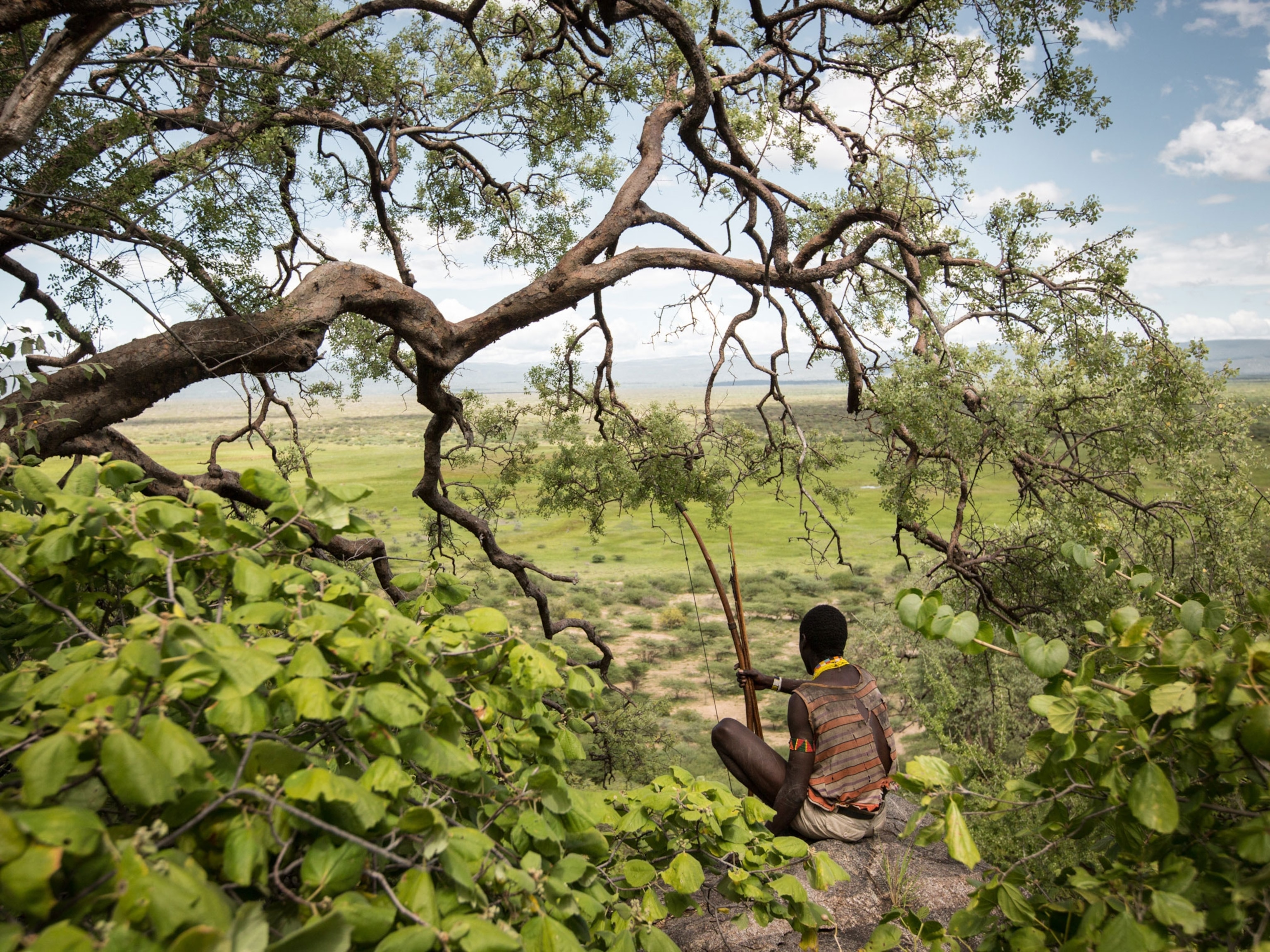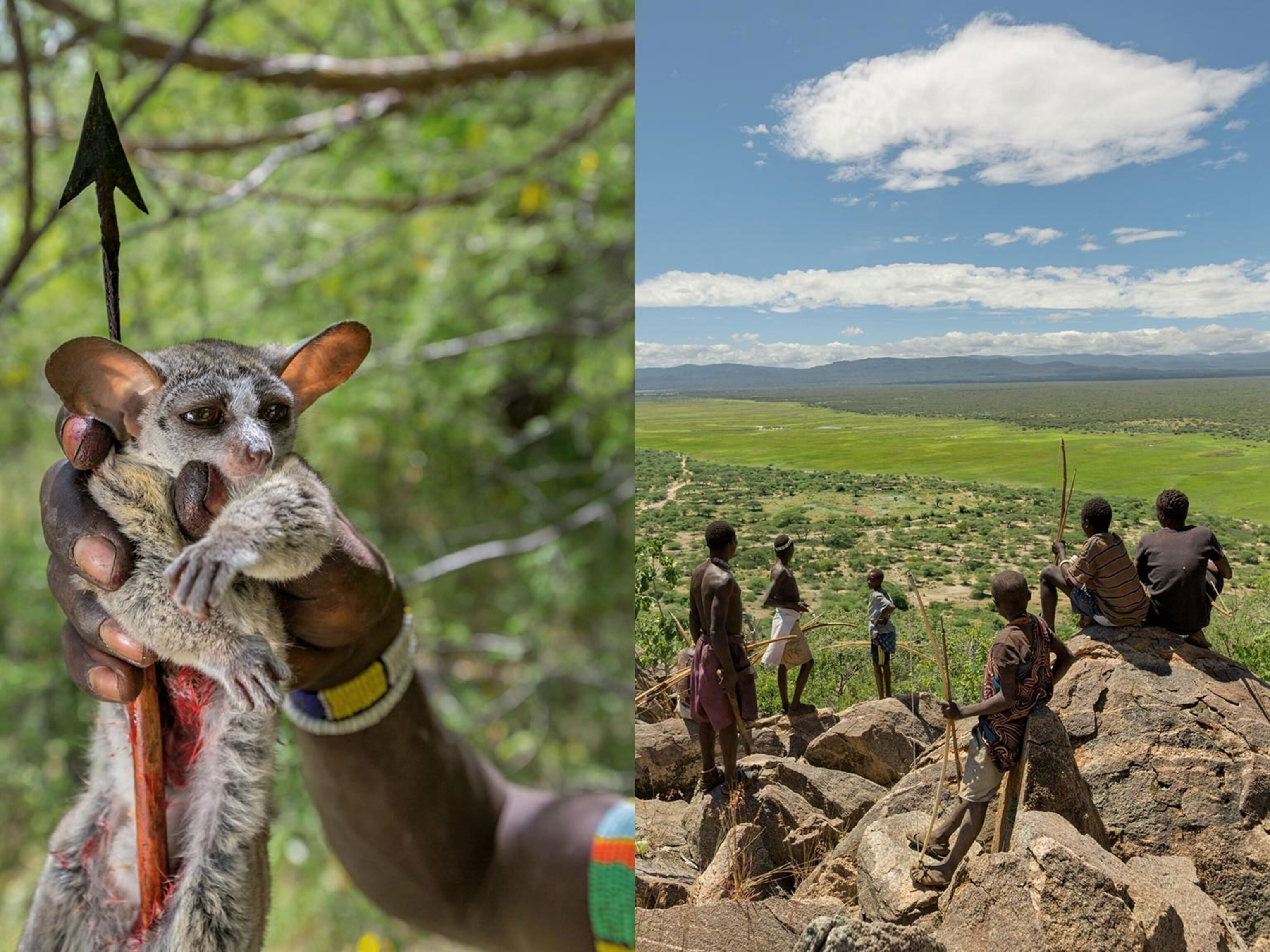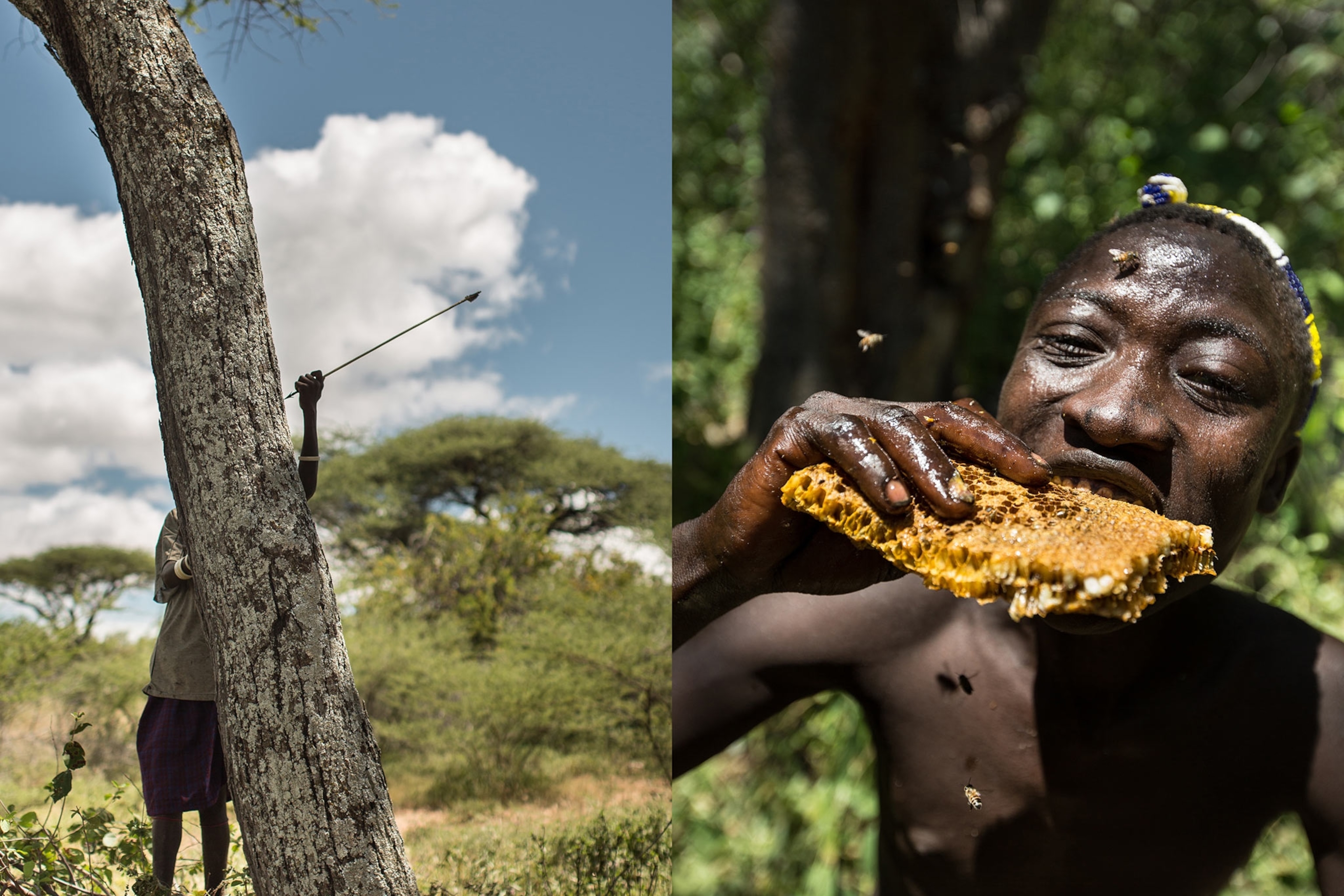
We Are What We Eat: Hunting the Hadza Way With Bows, Arrows, and Ingenuity
Greenland, Bolivia, Malaysia, Pakistan, Crete. After traveling to five different countries in search of the origins of the human diet, Matthieu Paley comes to the last stop in his journey, Tanzania.
April 2014
I felt like a headless chicken. All along the course of this story—while photographing the Tsimane, the Inuit, the Bajau—my editor Pamela Chen and I had been constantly researching the next stop, changing course as needed. Africa, however, was proving to be especially challenging. It seemed this part of this story could be told both everywhere and nowhere. The continent was so vast, so many tribes!
I “just” needed to photograph a community whose diet was completely free of food from outside sources. Self-sufficiency was a must: everything they ate must either be foraged, hunted, grown or herded. No influence of foreign aid.

I contacted university professors, fellow National Geographic photographers, writers, NGO workers, and local guides for their advice: There were the Aka, the !Kung, the Konso who still grew an ancient grain (“They have a king, a colorful character”), the Ganjule who lived near a very large lake (“But be very careful if they go hunt hippo!”), the Maasai where I could get a taste of milk and blood from the same animal, the Surmas near Tungit (how do they eat with those massive lip plugs?)
“Hold on,” an eager guide e-mailed me one morning, “I think the Suri people are more related to your profession, go there!” The Ovatue (as noted on a piece of scrap paper: four days round trip, weather depending) must be way better than the overrated Humba. And I should seriously consider the Berbers in northern Mali and go to northern Ghana and Malawi too, but most definitely forget about the northern Omo valley—way too many tourists there! Wait, Pam and I had to ask each other, did we need pastoralists or 100% foragers?
I couldn’t make head nor tails of any of this. I felt lost in my ocean of tribes with cool names. Of course there were the Hadza. The many PhDs and world-class anthropologists had all been pointing me in this direction: the Hadzas, nicely tucked away in Tanzania, have probably the most ancient diet on earth.
The Hadza were perfect. Except that National Geographic had put them on the cover just few years back, and it was understood the images were still too fresh in the reader’s mind. I had to look elsewhere—hence my headache and all these scribbled notes piling up on my desk.
But then it came, on that fine evening of February 5th, at 11:48 p.m., a magical e-mail from Pamela: “Good news! I spoke with Sarah Leen [the Director of Photography] today to get her advice on revisiting the Hadza. If you shoot it differently, she thinks it shouldn’t be a problem!” The thorn in my side was gone. The Hadza would have me.
*****
Flash forward a few weeks and I have arrived in the Yaeda valley. Now I have never liked hunting, especially the modern version—the loud bang, the bright orange jackets, the oozing testosterone. It’s way too much like modern warfare. When you hunt, I think you should do it by fair means, with respect for the life you are taking and without greed.
Hadza only hunt with bow and arrow, and as it turns out, I quite like the experience. It’s more like a long, silent trek (and yes, lions are around) with the chance of an adrenaline rush followed by a gamey snack. In Hadzaland, the incredible challenge of hunting is self-limiting—more often than not, you bring nothing back to camp. In this pristine savannah, wildlife doesn’t deplete as long as agriculturalists or pastoralists leave the place untouched, which so far, they more or less have.

Apart from larvae in honeycomb—eaten together with the honey it tastes salty, sweet, sour, delicious—most of the Hadza’s protein intake comes from hunting. Kauda and January (like the month) are some of the best hunters and trackers. And they better be; because with me as an added member of the hunting party, the challenge has just been increased. My exotic smells act like a well-tuned alarm system, generously aired to the surrounding wildlife.

Kauda makes sure to remind me of that on a regular basis. They nickname me “pompom”—meaning something like “thick guy.” I have a way to go before being fat, but compared to the average Hadza body—most of them have a fabulous six-pack and could easily pose for the cover of Men’s Fitness—I am definitely “pompom.”
We walk for three days, seeing cute dik-diks bobbing around (too far to even aim at) and a family of warthog (the poisoned arrow bounced off its head, and left the arrow completely bent). We hear the hiccup-like braying sounds of zebras.
And then, the guaranteed highlight of my past and future hunting experience—we get so close to a giraffe that January actually has a shot at it. That is: he takes off his sandals to avoid breaking twigs, looks deep into my eyes and asks me to be extra quiet, walks half-bent for half-a-mile, picks a poisoned arrow, aims and shoots. Not for fun, and not because I am there, but in the hope of getting some extra protein for himself and quite a large number of his people.

Hadza can hunt that kind of wildlife, off-limits to you and me. With the amount of meat to be had from large animals like these, the whole camp (between 20 and 30 people) would actually move next to the carcass.
The arrow goes in near the flank of the giraffe. In the silence, I can actually hear the sound of it penetrating the flesh. A cycle is completed—from arrow to target. Compare that to a gunshot, when all you hear is the explosion, ears ringing in the aftermath.
We track the wounded giraffe for over an hour. The track starts to get “drunk” as the poison takes effect. I am tense. January says we should return to camp before it gets dark; we will continue tracking in the morning. I am ready to push on, my head filling with grand ideas of award-winning shots. And that is where they will remain—in my head.
The next day, after another hour of speed walking, Kaunda starts going around in circle. The track has grown faint. The giraffe had overcome the poison and apparently slept here before moving on. No drama of a silent giraffe drawing her last breath in a clearing of long brown grass. No Matthieu shooting an overhead shot hanging from a nearby tree, with the mist rising all around. I am truly happy that the giraffe survived—but I would have liked that shot too.

On the return, Kaunda hunts a hyrax sunbathing on a rock and some blood splatters on my camera. The poor thing looks—and tastes—like a large rodent, far from my majestic giraffe. I’ve read it is related to the elephant. That was the end of my hunting story: a rodent whose long lost father was an elephant, being cooked whole on a fire.
The Hadza were the most intense experience I had while working on this story on the evolution of the human diet. They do not practice agriculture, herd animals, or even store any food. There is nothing to eat at camp in the morning. They walk in the surrounding savannah for a few hours and gather what they need: berries, honey (there is even a bird who sometimes guides them on that venture), tubers and tangy baobab-fruits. And yes, sometimes animals fall, hit by their arrows, but not out of greed.


Our ancestors all had that lifestyle at some point in history. Your ancestors too. Hadzas have the oldest mitochondrial DNA ever tested in a human population; they might in fact be among the “oldest” lineages on earth. Some anthropologists argue that the Hadza ancestors may have been where they are for 50,000 years.

The Hadza are nomads and live in camps made of twigs covered with grass, like upside-down nests. When they leave a camp behind, the twigs and grass fall off and eventually go back into the soil. There are no cemeteries, no traces left behind. Thousands of years and it can be argued that they have left no impact on their environment.
Most of all though, what marks my time with the Hadza is how happy they seem. In their language, there is no word for “worry”. The concept of “worrying” is something that is related to either the future or to the past. In their ancestral ways, the Hadza truly live in the moment. When focusing on daily survival is the most natural thing to do, there is no need for chakra alignment to get yourself centered, or mindfulness courses to experience the here and now. The Hadza, without overthinking it, have kept their focus unchanged, and that is admirable.

From here Paley headed straight to National Geographic headquarters in Washington, D.C. to share with his editors the best of his photographs from all of the places he visited. The final story, “The Evolution of Diet,” was published in the September issue, as part of National Geographic’s special “Future of Food” series.
The nine days Paley spent with the Hadza were so inspiring that he will be returning to photograph them in 2015, thanks to a grant from the French Museum of National History. In the meantime, Follow Paley on Twitter, Instagram, and his website.
Read about Chen and Paley’s approach to photographing the evolution of diet story in “We Are What We Eat: Documenting Dinners Around the World,” and then journey with Paley to Afghanistan, Greenland, Bolivia, Malaysia, Pakistan, and Crete.
You May Also Like
Go Further
Animals
- How can we protect grizzlies from their biggest threat—trains?How can we protect grizzlies from their biggest threat—trains?
- This ‘saber-toothed’ salmon wasn’t quite what we thoughtThis ‘saber-toothed’ salmon wasn’t quite what we thought
- Why this rhino-zebra friendship makes perfect senseWhy this rhino-zebra friendship makes perfect sense
- When did bioluminescence evolve? It’s older than we thought.When did bioluminescence evolve? It’s older than we thought.
- Soy, skim … spider. Are any of these technically milk?Soy, skim … spider. Are any of these technically milk?
Environment
- Are the Great Lakes the key to solving America’s emissions conundrum?Are the Great Lakes the key to solving America’s emissions conundrum?
- The world’s historic sites face climate change. Can Petra lead the way?The world’s historic sites face climate change. Can Petra lead the way?
- This pristine piece of the Amazon shows nature’s resilienceThis pristine piece of the Amazon shows nature’s resilience
- Listen to 30 years of climate change transformed into haunting musicListen to 30 years of climate change transformed into haunting music
History & Culture
- Meet the original members of the tortured poets departmentMeet the original members of the tortured poets department
- Séances at the White House? Why these first ladies turned to the occultSéances at the White House? Why these first ladies turned to the occult
- Gambling is everywhere now. When is that a problem?Gambling is everywhere now. When is that a problem?
- Beauty is pain—at least it was in 17th-century SpainBeauty is pain—at least it was in 17th-century Spain
Science
- Here's how astronomers found one of the rarest phenomenons in spaceHere's how astronomers found one of the rarest phenomenons in space
- Not an extrovert or introvert? There’s a word for that.Not an extrovert or introvert? There’s a word for that.
- NASA has a plan to clean up space junk—but is going green enough?NASA has a plan to clean up space junk—but is going green enough?
- Soy, skim … spider. Are any of these technically milk?Soy, skim … spider. Are any of these technically milk?
Travel
- Could Mexico's Chepe Express be the ultimate slow rail adventure?Could Mexico's Chepe Express be the ultimate slow rail adventure?
- What it's like to hike the Camino del Mayab in MexicoWhat it's like to hike the Camino del Mayab in Mexico







